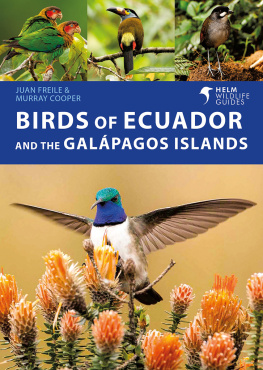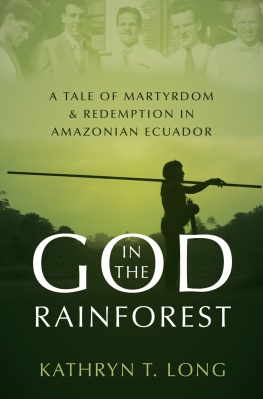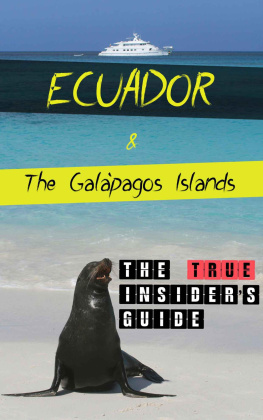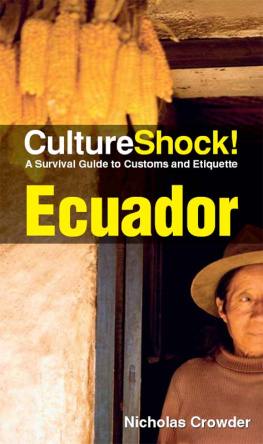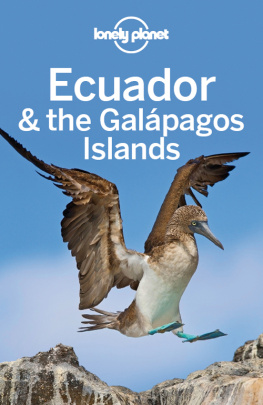Laura Rival - Trekking Through History: The Huaorani of Amazonian Ecuador
Here you can read online Laura Rival - Trekking Through History: The Huaorani of Amazonian Ecuador full text of the book (entire story) in english for free. Download pdf and epub, get meaning, cover and reviews about this ebook. year: 2002, publisher: Columbia University Press, genre: Politics. Description of the work, (preface) as well as reviews are available. Best literature library LitArk.com created for fans of good reading and offers a wide selection of genres:
Romance novel
Science fiction
Adventure
Detective
Science
History
Home and family
Prose
Art
Politics
Computer
Non-fiction
Religion
Business
Children
Humor
Choose a favorite category and find really read worthwhile books. Enjoy immersion in the world of imagination, feel the emotions of the characters or learn something new for yourself, make an fascinating discovery.
- Book:Trekking Through History: The Huaorani of Amazonian Ecuador
- Author:
- Publisher:Columbia University Press
- Genre:
- Year:2002
- Rating:3 / 5
- Favourites:Add to favourites
- Your mark:
- 60
- 1
- 2
- 3
- 4
- 5
Trekking Through History: The Huaorani of Amazonian Ecuador: summary, description and annotation
We offer to read an annotation, description, summary or preface (depends on what the author of the book "Trekking Through History: The Huaorani of Amazonian Ecuador" wrote himself). If you haven't found the necessary information about the book — write in the comments, we will try to find it.
Trekking Through History: The Huaorani of Amazonian Ecuador — read online for free the complete book (whole text) full work
Below is the text of the book, divided by pages. System saving the place of the last page read, allows you to conveniently read the book "Trekking Through History: The Huaorani of Amazonian Ecuador" online for free, without having to search again every time where you left off. Put a bookmark, and you can go to the page where you finished reading at any time.
Font size:
Interval:
Bookmark:
Trekking Through History

THE HISTORICAL ECOLOGY SERIES
THE HISTORICAL ECOLOGY SERIES
William Bale and Carole L. Crumley, Editors
This series explores the complex links between people and landscapes. Individuals and societies impact and change their environments, and they are in turn changed by their surroundings. Drawing on scientific and humanistic scholarship, books in the series focus on environmental understanding and on temporal and spatial change. The series explores issues and develops concepts that help to preserve ecological experiences and hopes to derive lessons for today from other places and times.
The Historical Ecology Series
William Bale, Editor,
Advances in Historical Ecology
David L. Lentz, Editor,
Imperfect Balance: Landscape Transformations in the Pre-Columbian Americas
Roderick J. McIntosh, Joseph A. Tainter, and Susan Keech McIntosh, Editors,
The Way the Wind Blows: Climate, History, and Human Action
Laura M. Rival
Trekking Through History
THE HUAORANI OF AMAZONIAN ECUADOR

COLUMBIA UNIVERSITY PRESS  New York
New York
COLUMBIA UNIVERSITY PRESS
Publishers Since 1893
cup.columbia.edu
New York Chichester, West Sussex
Copyright 2002 Columbia University Press
All rights reserved
E-ISBN 978-0-231-50622-9
Library of Congress Cataloging-in-Publication Data
Rival, Laura M.
Trekking through history : the Huaorani of Amazonian Ecuador / Laura M. Rival.
p. cm.(The historical ecology series)
Incluces bibliographical references and index.
ISBN 0231118449 (cloth)ISBN 0231118457 (pbk.)
1. Huao IndiansMigrations. 2. Huao Indians-History. 3. Huao IndiansSocial life and customs. 4. NomadsEcuadorHistory. I. Title. II. Series.
F3722.1.H83 R58 2002
986.600498-dc21
2001042394
A Columbia University Press E-book.
CUP would be pleased to hear about your reading experience with this e-book at .
Designed by Lisa Hamm
To La, my little daughter
On connait mieux la pense des socits que leur corps.
ANDR LEROI-GOURHAN
Contents
Maps
Figures
Photographs
Tables
T his monographic study on the Huaorani intends to situate them ethnographically within Amazonian anthropology. It focuses on the description and interpretation of their trekking way of life, approached from the perspective of concepts about the person, death, predation, incorporation, and growth. Concerned with the fact that Amazonian anthropology has been split between studies of human adaptation to their natural environments and studies of the ways in which nature is used symbolically and ritually to signify society or transcend human finitude or both, I have tried to grasp the Huaoranis contemporary ethnographic reality and historical agency by articulating history and cosmology, ritual and ethnicity, and symbolic and political economy analysis.
This book is an attempt to present ethnographic data on a small-scale society characterized by a high degree of mobility and disengagement from horticulture and to offer generalizations valid for other highly mobile societies of the Northwest Amazon. The theme of natural abundance, a cultural category in terms of which the Huaorani organize their own experience of the ongoing relationship they sustain with the forest in the course of provisioning their society, is central to understanding their mode of trekking. Mobility is not primarily determined by economic or ecological factors but represents the historical development of a distinct mode of life that the notions of archaism and agricultural regression cannot explain satisfactorily.
While a number of anthropologists influenced by postmodern thinking consider the monograph an entirely obsolete form of scholarship linked to early twentieth-century colonialism and ways of thinking, I can see no better way of conveying a nonindustrial culture in all its difference, integrity, and unique aesthetic, moral, and political response to the human condition. This is especially true for the Huaorani who, from their tragic encounter with North American missionaries in 1956 to this day, have held a special place in sensationalistic journalism and popular imagination as Ecuadors last savages. I will never forget that the first talk I was asked to give in Ecuador as part of my research cooperation commitments with the Ministry of Culture and Education did not concern their culture or social organization (of which they were assumed to be lacking, either because of their extreme savagery or because of their advanced state of acculturation by Quichua neighbors) but the various media discourses about them.
Norman Whitten wrote in 1978 that more than any other native people of the Oriente [Ecuadors Amazon region], the contemporary Huaorani exist not only as a people facing new cataclysmic changes in their territory, but also as a people known primarily by false and distorted myths which present their culture through the eyes of those seeking to convert it and subvert it. I hope this study will convince the reader that despite the civilizing efforts of missionaries and schoolteachers, the Huaorani have largely retained their distinctive way of apprehending the world.
Approximately fourteen hundred, today, with 55 percent of the population under sixteen (compared to a population of under six hundred when first surveyed in the early 1960s), Huaorani people have lived as forest trekkers in the heart of the Ecuadorian Amazon for hundreds of years (see
Like much of Western Amazonian rain forest, Huaorani land has no marked seasons. Annual precipitation, averaging 3,500 mm (120 in.), is evenly distributed throughout the year. Atmospheric humidity (80 to 90 percent) is constant, and soils, renowned as the least fertile in Ecuador, permanently damp. During fieldwork, I found the contrast between JuneJulysupposedly the wettest months of the yearand NovemberDecembersupposedly the driesthardly noticeable, and, given the relatively high rainfall averages, seasons almost nonexistent. What was striking, however, was the sharp fall in temperature after heavy rains, when it felt as cold as during the coldest nights (around 13C). And so was the dramatic transformation, after a heavy downpour, of the riverine landscape into a vast, desolate marshland. On the western side of Huaorani land, numerous streams and creeks cut across rugged terrain featuring sizable hills to form the Curarays headwater. On the eastern side, rivers meander through marshy lowlands. Game is abundant and biodiversity exceptionally high. Both the density of palms and bamboo groves and the frequency of potsherds and stone axes suggest that large tracks of forest are anthropogenic, that is, transformed by past human activities.
In 1969, a decade after having pacified the Huaorani, the Summer Institute of Linguistics (SIL) was authorized to create a 66,570-hectare [169,088-acre] protection zone (the Protectorate) around its mission. By the early 1980s, five-sixths of the population was living in the Protectorate, which represented one-tenth of the traditional territory. Since the creation of primary schools, which has accelerated the process of sedentarization and riverine adaptation, the population has gathered into twenty communities, almost all located within the boundaries of the former Protectorate (see ). In April 1990 the Huaorani were granted the largest indigenous territory in Ecuador (679,130 hectares, or 1,098,000 acres). It includes the former Protectorate and adjoins Yasun National Park (982,300 hectares, or 2,495,000 acres).
Next pageFont size:
Interval:
Bookmark:
Similar books «Trekking Through History: The Huaorani of Amazonian Ecuador»
Look at similar books to Trekking Through History: The Huaorani of Amazonian Ecuador. We have selected literature similar in name and meaning in the hope of providing readers with more options to find new, interesting, not yet read works.
Discussion, reviews of the book Trekking Through History: The Huaorani of Amazonian Ecuador and just readers' own opinions. Leave your comments, write what you think about the work, its meaning or the main characters. Specify what exactly you liked and what you didn't like, and why you think so.




